In the account book of the joiner John Head (1688-1754) there are debit entries for 45 desks, the first entry coming in 1719, two years after Head immigrated from England to Philadelphia, the last in 1742, two years before he ended his production of furniture.
Compared to chests of drawers, there are few extant desks made before 1740 that can be attributed to the Delaware River Valley. To date, only one desk, in a private collection, has been attributed to the shop of John Head.
For an unsigned or undocumented object to be attributed to a specific maker, the object must conform in multiple and significant ways to signed or otherwise documented objects from that maker. Some features regarded as characteristic of furniture documented to the shop of John Head have been discussed in previous posts. The desk described and illustrated below follows the construction, design, and idiosyncratic drawer marking system of the Wistar family documented high chest and dressing table while at the same time expanding of our knowledge of Head’s woodworking ability and inventiveness.
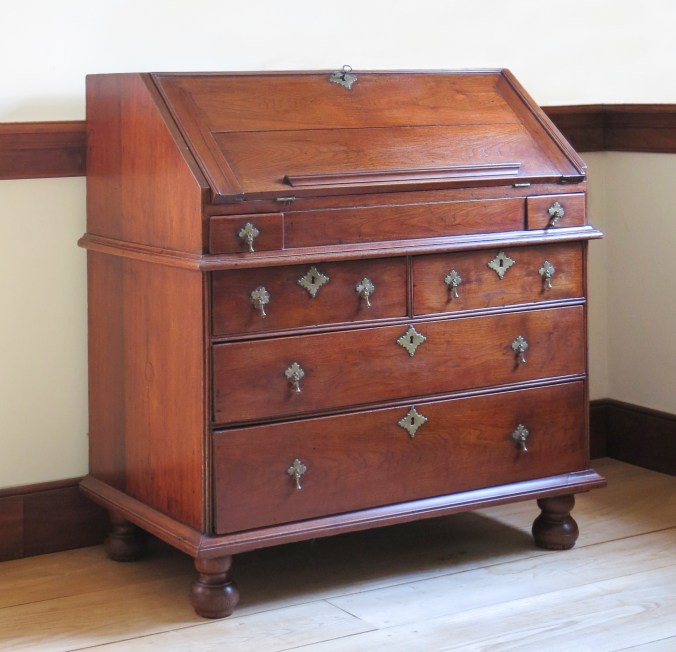
Three-quarter view of a desk attributed to John Head. Made in Philadelphia, 1720-1740. Black walnut, hard pine, Atlantic white cedar, yellow poplar, brass, iron. Private collection.
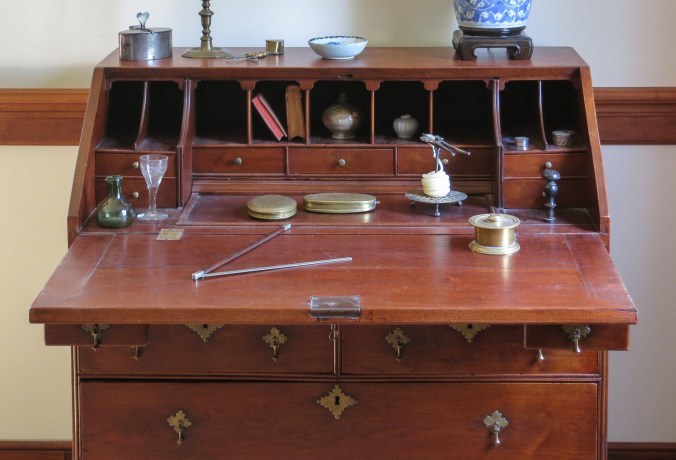
The fall opens to the writing compartment of the desk.

The three long drawer that vary in height are all marked in white chalk with a semi-circle and single vertical slash placed at the center of the backs.

The two short drawers of similar height have Head’s unique system of whorls, Vs, and slashes used to identify drawer parts that are the same height. Marks from a bench hook can be seen along the upper edge of the back.
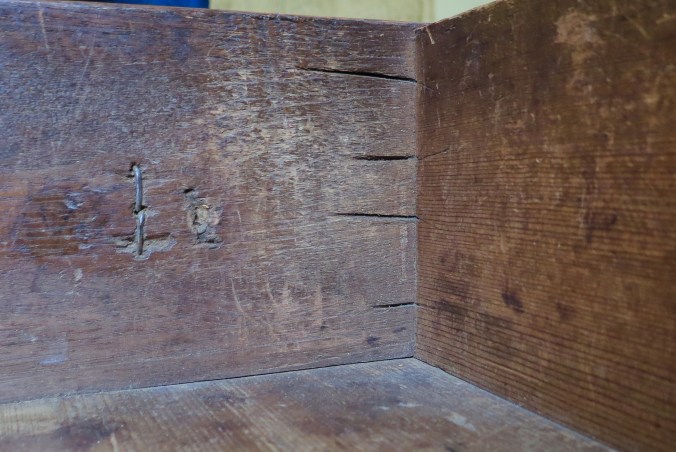
Sawing past the gauge line on the interior of the drawer fronts to facilitate removal of waste from the recesses for the dovetails cut on the sides.
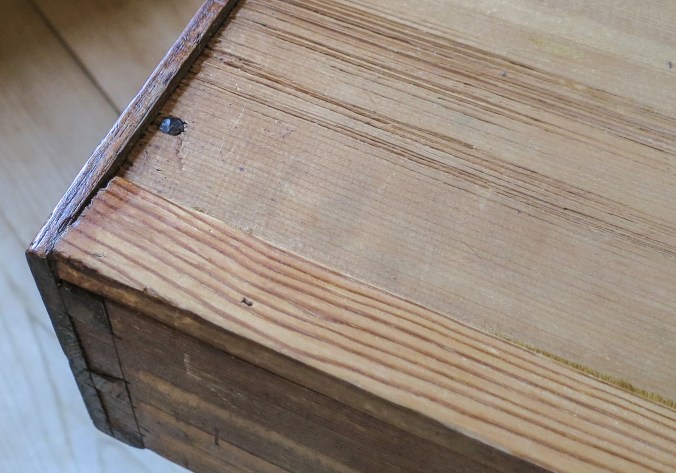
The drawers of the desk are made in the same manner as the Wistar family chests. The long drawers have deep rebates on the front twice the thickness of the cedar bottoms. Hard pine runners are glued to the bottoms at the sides. The witness from a sprig, used as a clamp while the glue used to attach the runner dried, can be seen two inches back from the front edge of the runner.
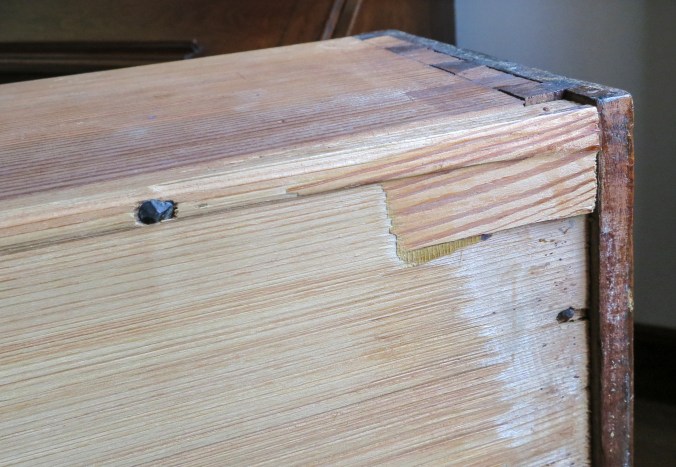
This desk has seen considerable use to the extent that the hard pine drawer runners are entirely worn away in places. The wear offers us a glimpse into Head’s working practice, full size rosehead nails, like those used use at the front and back of the drawer bottom, were also used along the sides, concealed under the runners.
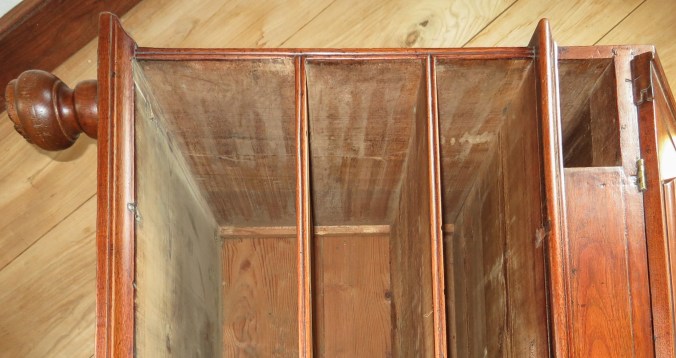
As on the Wistar chests, full height, square section drawer stops are nailed and glued to the sides of the desk immediately in front of the backboards.
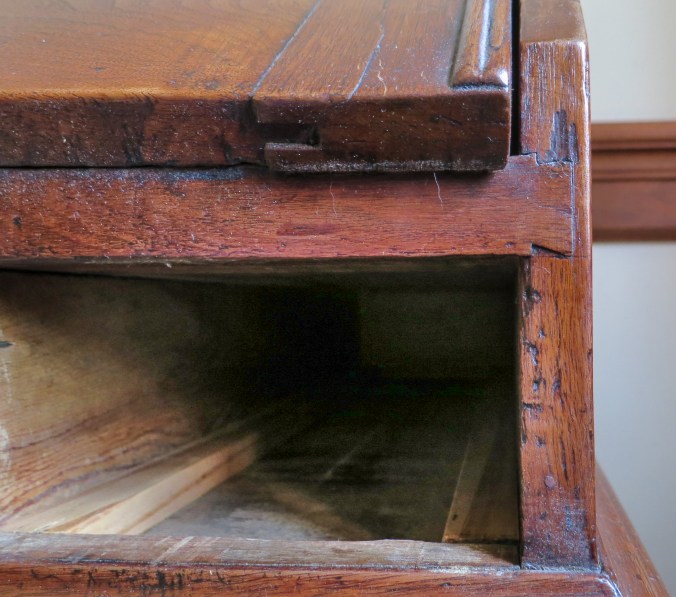
By their nature, desks require more complex joinery solutions than chests of drawers. This view shows a drawer opening for one of a pair of drawers that, when withdrawn, support the hinged writing surface. No double-arch moulding can be used on the rail the fall is hinged to as it would interfere with the fall when opened. The joinery of the rail to side is thus exposed, revealing that Head used the most elaborate form of a dovetail housing joint.
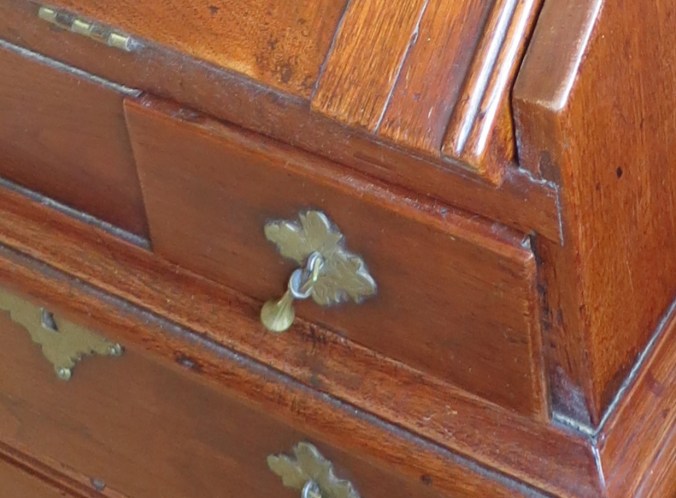
Head used the absence of moulding around the fall support drawers to create a drawer front unlike any other in furniture documented or attributed to him, he extended the drawer fronts past the sides to act as stops, creating one of the earliest instances of a lipped drawer front made in Philadelphia. Head used lipped waist doors on some of his clock cases, as those doors could not be stopped with blocks at the back of the case as the drawers of the desk are and clock door hinges were prone to damage if inadvertently pushed past the closed position. There was a different reason to use a lip on these drawers however, as Head could easily have placed stops at the back of the drawer opening as he did on the all the other drawers of the desk. Double or single arch moulding on case furniture was decorative but had another important function. Mouldings surrounding the drawer fronts helped disguise the fact that sides, tops, and bottoms of furniture constructed of dovetailed boards eventually shrank while the front to back length of the drawers did not. When the sides of the desk ultimately shrunk, drawers without lips would have sat noticeably proud of the sides and rails.
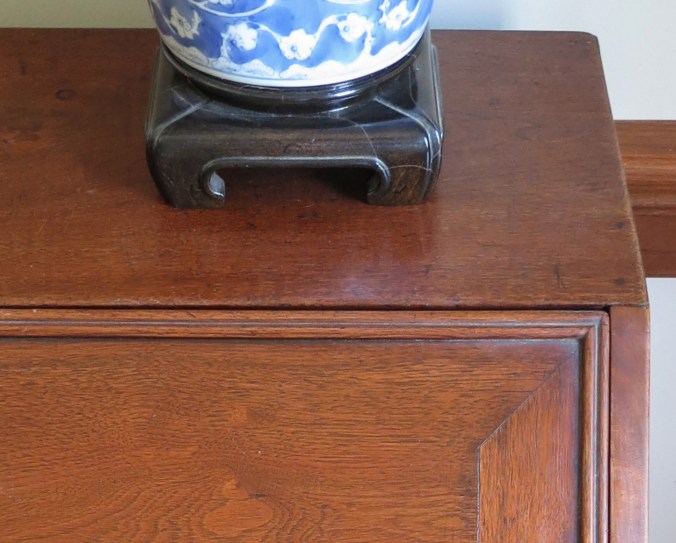
One of the biggest technical surprises of the desk is that Head used a mitered-dovetail to join the top of the desk to the sides.
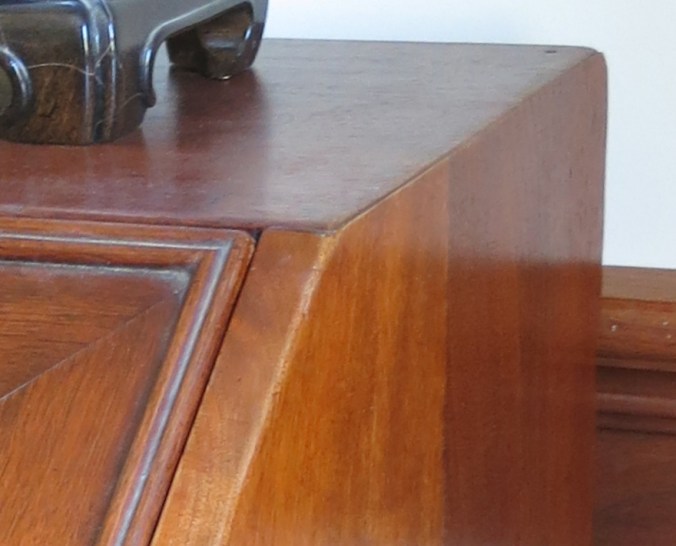
Sometimes called a blind miter-dovetail, the joinery is completely concealed with no end grain visible. This desk joint is further complicated by the 45 degree slope of the side and the angled edge at the front of the top board that mates with the top edge of the fall. There is a level of sophistication and neatness in the use of this joint at the corners of a desk the belies the description of Head as solely a joiner to the middling class. This joint is rarely seen on desks made anywhere in the Colonies throughout the eighteenth century. The most refined cabinetmakers would typically lap-dovetail the sides of a desk to the top of even their most elaborate creations.
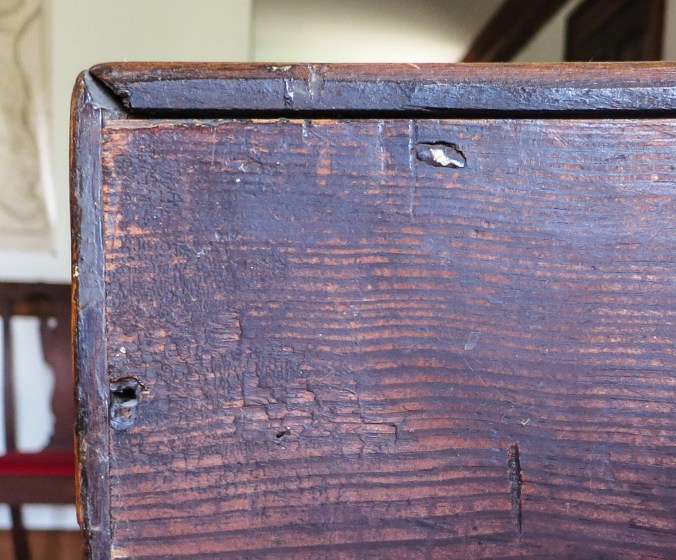
The miter-dovetail top-to-side joint seen from the back of the desk.
Next: “To a Walnut Desk” Part II, The Writing Compartment
Thank you Chris for another excellent post.
I find this desk fascinating; not the least because Head is a documented English cabinetmaker who worked in the first half of the eighteenth-century.
Head appears to have followed all the best practices of the period and with the use of three different species of secondary wood, it is interesting to see he matched the pine drawer runners to pine guides in the carcase.
The dovetail joint of the desk floor to the carcase gables is unusual in that not only is the dovetail cut into the gables, but the whole rail is cut in to a depth of (I’m guessing) an eighth of an inch.
Another detail I find strange are the two loper drawers beneath the fall. If, as you note, Head could have easily placed internal stops at the back of the carcase, why did he lip the fronts of the loper drawers? If he was cognizant of the inevitability of front-to-back carcase shrinkage and was concerned about long term drawer protrusion, why didn’t Head lip all the drawer fronts?
Lipped drawer fronts first appeared in England around 1730 (21 years after Head emigrated to the colony). Did Head ever return to Mother England, or did he keep abreast of English trends through correspondence or meeting newly arrived immigrants? Or could these lipped drawer fronts be purely coincidental, or indeed, have another purpose?
Is it possible the loper drawer fronts were lipped along their top edge to better level the open fall and the remaining two (three?) edges were lipped to balance the appearance?
With Head being an accomplished and conversant English cabinetmaker, and recently arrived in the colony, it seems odd that his interpretation of the bun foot should differ so widely from the (virtually universal) English bun foot.
JP
Thank you Jack Plane, and exactly why I described the dovetail housing as elaborate, just as you say, the whole rail at full thickness is cut into the side, along with angled cuts at both top and bottom. As you know, many cabinetmakers will create a half dovetail on the rail and not have the rail enter any further than the dovetail shoulder. Head’s joint is more difficult to execute, even if the rail depth is only several inches. (I’ll show views of that in the next post.)
I don’t know why Head did not lip all the drawers, though I believe he did adapt this method of working towards the end of his career. Perhaps he was just not ready to abandon his ways of working. These loper drawers, being narrow and not carrying much weight, have nailed on, flat running bottoms, so the alternative way of stopping drawers, with slips of wood glued to the rail that stop the drawer front of a raised bottom drawer as seen on cock-beaded drawer fronts, could not be used here. The top edges of the lopers are NOT lipped, just the sides.
Yes, Head had a distinctive way of turning feet and they are easily recognizable. I think part of the reason they look like they do comes from an innovation he made to turned high chest and dressing table legs that I haven’t address here to date. However, there is one clock case with surviving original feet that follow the English mode of bun feet more than his feet for other furniture forms.
It is a fascinating question about how makers kept up with trends and changes in fashion during their careers. I don’t believe there is any evidence Head ever returned to England, most tradesmen did not. Like other makers, he presumably relied on newly arrived immigrants, especially those needing work, to stay up-to-date. How Head and his apprentices and journeymen dealt with the changes in furniture design during the decade of the 1730s is something to deal with in the future.
Chris
Thank you for your in-depth reply and clarification of the loper drawer front. I look forward to future posts on Head and his work.
JP
Reblogged this on Pegs and 'Tails and commented:
Christopher Storb has written an interesting post on a walnut bureau made by the English joiner, John Head, who emigrated to Philadelphia in 1717.
Very nice, thank you for spreading the word!
Beautiful piece. Thanks for sharing. The lid construction looks interesting too. Would you call it a mitered breadboard? How does the lid lock compensate for expansion/contraction?
The lid, or fall, has a sort of miter/tenon construction common to many eighteenth century desks. I’ll describe it in more detail in later posts.
There is not much compensation for shrinkage! You use a board with low moisture content when constructing the desk and hope the lock bolt has a long throw. Desk falls are an area that have caused difficulties in historic furniture since the advent of central heating.